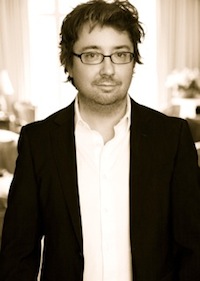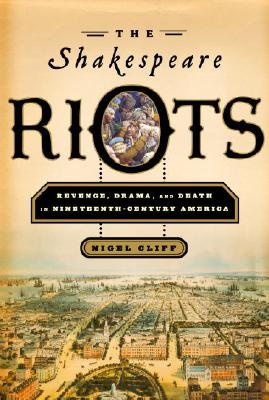Nigel Cliff is a full time author and historian, holding an English degree from Oxford University. His 2007 book The Shakespeare Riots was released to high acclaim, earning recognition as one of the best nonfiction books of the year byThe Washington Post. In it, he recounts the 1849 bloody riotous aftermath of the long-held feud between the leading Shakespearean stars of the era, American Edwin Forrest and Briton William Macready. A conflict grown out of personal rivalry, class dispute, and explosive Bardolatry (that is the extravagant reverence of William Shakespeare), the Shakespeare riots underscore a shift in the seemingly innocuous presence of Shakespeare in American culture.

In conjunction with the current exhibition Shakespeare in Print and Performance, on Thursday April 14, at 7 p.m., Cliff will be at the Ransom Center to deliver the lecture The Shakespeare Riots, exploring the 1849 feud in greater depth. Prior to his visit, Cliff spoke with Cultural Compass to provide his insights on the causes and consequences of the violent day.
As a jumping off point for our readers who may be unfamiliar with the 1849 Shakespeare Riot (or, as it is also known, the Astor Place Riot), could you provide some background?
“The Shakespeare Riots” is my term for the extraordinary series of events that culminated in the Astor Place Riot of May 10, 1849. That evening between ten and twenty thousand demonstrators crammed into the streets around New York’s Astor Place Theater, where an English actor was trying to play Macbeth. A hard core of rioters drawn from New York’s infamous gangs scaled the walls, smashed the windows, and tried to burn down the building. The police lost control and called in the military, but the cavalry was driven off, the infantry nearly collapsed, and for the first time in American history troops fired point-blank into the crowd, killing at least 25. As a direct result an American police force was armed with lethal weapons for the first time-and yet this unlikely tragedy had its genesis in a comically bitter feud between two actors. The Englishman William Charles Macready was the darling of the kid-gloves crowd; his rival Edwin Forrest, the first great American star of the stage, had an altogether rowdier following. As they chased each other from town to town, staging competing performances and whipping up their partisans with outraged speeches, pamphlets, and letters, they unwittingly found themselves the rallying cries in a mounting cultural war between nativists and Anglophiles over America’s very identity. With Bardolatry at its all-time zenith, that struggle revolved around the question of which nation and class “owned” Shakespeare.
How common were theater riots during this period? Was the Shakespeare riot notable simply because it happened, or for its scale?
Theater riots weren’t so common that they were taken for granted, but they weren’t uncommon, either. In a time before professional sports had begun to attract a mass public, theatres were the great democratic meeting-places, and audiences from top to bottom took it as their right to make their displeasure loudly and sometimes physically known. In pre-Revolutionary America, the Stamp Act riots of 1765 saw the Sons of Liberty chase the audience out of a New York theater and take apart the building plank by plank to stoke a huge bonfire. After Independence, English actors continued to dominate American entertainments–even on the frontier, where the Chapman family troupe built the first Mississippi showboat, a rudimentary floating theatre on which they frequently performed Shakespeare. Actors were the public face of England in America–they toured more widely than American politicians, let alone English ones – and whenever anti-English feeling ran high they became the target of popular ire. Posters would go up calling on patriots to pelt the slanderer off the stage. Crowds 5000-strong would batter down the doors and windows, throw coins, fruit, and eggs at the stage, and chant “Off! Off! Go back to England!” But nothing nearly approached the scale of the Astor Place Riot.
Can you expand upon the concept of “Bardolatry,” or fanatic admiration of Shakespeare? Is there an ideological equivalent of this sentiment today?
Bardolatry, or the worship of Shakespeare as a secular god or master spirit, began in the eighteenth century with the actor David Garrick as its high priest. In early nineteenth-century England, to Macready’s disgust, it had been largely lost to a sensationalist taste for gory melodramas and performing animals; Queen Victoria was fond of both and managed to avoid seeing a single Shakespeare play for six years. Macready and his friend Thomas Carlyle helped revive it, but it flourished in America more than anywhere: Ralph Waldo Emerson once suggested that in climes beyond the solar road they called the Earth Shakespeare. What fascinated me was that Bardolatry was no means the preserve of the elite. During my research I discovered mountain peaks, canyons, mines, boats, saloons, almanacs, medicines, and whole towns named after Shakespeare and his characters. I came across pilots on Mississippi steamboats who recited Shakespeare by the hour and grizzled Gold Rush miners who whiled away time when the ground was too hard to dig by reeling off King Lear from memory. Oftentimes when they went to the local theater, they knew the plays better than the actors–and shouted out the prompts to prove it. Forrest in particular drew vast rowdy audiences who thrilled to his heroic performances of Shakespeare. That was how it happened that elitists and populists came to blows over the Bard. It would never have happened over opera, or drawing-room comedy.

To what extent was the 1849 riot symptomatic of deepening class divisions and growing class conflict in addition to a personal dispute between the two actors?
The reason the riot happened is that the two became inextricably bound up. The 1840s were years of mass immigration, especially from Ireland, and rampant nativism. Rival native and Irish gangs were terrorizing New Yorkers, and demotic politicians latched onto the anger. On a broader scale, a new America was being born on the frontier that turned its back on the Anglophile East Coast. The elite was terrified that it was about to lose control, and it decided to make a stand. To us it seems bizarre that a theater was the chosen battleground, but there was something almost inevitable about what happened. Theaters dominated the public space and enacted America’s developing identity on their stages. Macready and Forrest were the leading actors of their nations, and they were also peculiarly identified with two competing classes. Their very public rivalry blew the class conflict over the future of American culture into the open.
How did this riot alter the American public’s reception of Shakespeare?
The riot and the forces behind it hastened the removal of Shakespeare in performance to a realm labeled “High Culture.” The old Shakespeare was not pure Shakespeare; the plays were cut and changed at will and embellished with acrobatics and song-and-dance acts. But they were the shared possession of men and women of every background and class. Soon after the riot, proper Shakespeare was being performed in what were advertised as theaters for the respectable classes, while vaudeville and variety halls catering to the working class burlesqued Richard III as Bad Dicky, Julius Caesar as Julius Sneezer, and Hamlet as Hamlet and Egglet. The gain in authenticity came at the cost of a loss of Shakespeare’s universal appeal and irreverent relevance.
What became of Forrest and Macready’s careers after the riot? To what extent were they each personally involved in the riot, if at all?
Macready escaped to England and retired from acting soon after the riot. He had labored to rescue the English theater from the depths it had sunk to in the early nineteenth century, but as an educated–and painfully sensitive–man, he had always been excruciatingly aware that acting was not in the England of those days the pursuit of a gentleman. Forrest weathered a scandalous divorce trial from his English wife and remained an idol to his supporters, but time and tastes outran him and, to his incomprehension he, too, became the hallmark of burlesques. For me, one of the most moving elements of this story is that Macready and Forrest started out as good friends before political tensions and outsize star egos pitted them against each other. They died four months apart, towering talents who are remembered for a riot that was only partly of their making. That’s because of the transitory nature of acting before recording, but also because of the way history writing revolves around controversies and oppositions–a process that I tried to resist as much as possible but which I realize I am guilty of furthering.
Related content
Read more about the exhibition Shakespeare in Print and Performance
Receive the Harry Ransom Center’s latest news and information with eNews, a monthly email. Subscribe today.
